#Traditional Meets Contemporary
Text
Trendy Color Combinations for Haldi Decor 2024
Gearing up for your Haldi ceremony? Searching for the perfect colour palette to decorate your venue can be a task. But Look no further! The haldi ceremony is often a vibrant and joyous pre-wedding ritual in all Indian weddings. This is celebrated with turmeric paste to bless the newbie bride and groom with blessings and auspiciousness. Recently Haldi decor has evolved a lot into a beautiful…

View On WordPress
#WriteAPageADay#Festive ambiance creation#Haldi ceremony colors#Haldi decor 2024#Indian wedding colors#Lifestyle#Stylish decor inspiration#Subtle neutral hues#Traditional meets contemporary#Trendy color combinations#Vibrant yellow decor#Wedding decor trends
0 notes
Text
Embroidered Chiffon Women Dresses Collection Vasl-e-Yaar 2023 By Asim Jofa

View On WordPress
#asim jofa#Captivating Threadwork#Celebratory Attire#Cultural heritage#ELEGANCE#Elegance and Sophistication#Embroidered Chiffon Dresses#Empowering Women#Ethereal Chiffon#Festive Elegance#Handcrafted#Innovative Design#Intricate embroidery#Luxurious Fashion#Modern Glamour#Romantic Silhouettes#Timeless Beauty#Traditional Meets Contemporary#Vasl-e-Yaar 2023#Versatility in Fashion#Womens Fashion
1 note
·
View note
Text
Embroidered Chiffon Women Dresses Collection Vasl-e-Yaar 2023 By Asim Jofa

View On WordPress
#asim jofa#Captivating Threadwork#Celebratory Attire#Cultural heritage#ELEGANCE#Elegance and Sophistication#Embroidered Chiffon Dresses#Empowering Women#Ethereal Chiffon#Festive Elegance#Handcrafted#Innovative Design#Intricate embroidery#Luxurious Fashion#Modern Glamour#Romantic Silhouettes#Timeless Beauty#Traditional Meets Contemporary#Vasl-e-Yaar 2023#Versatility in Fashion#Womens Fashion
0 notes
Text
Abstract Art: A Journey of Expression and Evolution
Read about the journey of Abstract Art in our new #blog live on our website now.
#Buy Original Paintings Online Indian Art Pieces Online#Explore Unique Online Paintings#Shop Exclusive Contemporary Art#Buy Original Indian Art Online#Traditional Indian Artwork Store#Modern Art Paintings for Home#Discover Affordable Art Online#Vibrant Canvas Paintings for Sale#Abstract Art Pieces Online India#Authentic Indian Art Prints#High-Quality Oil Paintings India#Watercolor Art Collections Online#Handcrafted Indian Artwork#Online Art Gallery Experience#Folk Art Paintings from India#Captivating Wildlife Paintings#Indian Heritage Art for Sale#Customized Artwork Online#Budget-Friendly Canvas Prints#Exciting Deals on Art Online#Meet Talented Indian Artists#Experience Indian Abstract Art#Serene Landscape Paintings#Exclusive Collections for Home#Artistic Gifts for Every Home#original artwork#paintings#sculptures#original serigraph art#Drawings
0 notes
Text
Uniting Old and New Styles in Modern Interior Design

View On WordPress
#backyard#balcony#bathroom#bedroom#Clean Lines And Curves#Contemporary Flair#Creative Fusion Of Eras#Eclectic Design Style#Harmonious Mix Of Styles#Home Decor Inspiration#Home Decor Love#home decoration#Home Staging Works#interior design#interior design catalog#Interior Design Community#Interior Design Goals#Interior Design Tips#interior design trends#living room#Minimalist Home#Mix Textures And Decor#modern interior design#Personal Style Expression#statement pieces#sweet home usa interior decoration#Timeless Elegance#Traditional And Modern Blend#Unexpected Combinations#Vintage Meets Modern
0 notes
Photo

Fire Pit Landscape in Denver
An example of a large traditional partial sun backyard concrete paver formal garden with a fire pit in summer.
0 notes
Text
Indigenous People's Day

DR. HENRIETTA MANN
Cheyenne
On this Indigenous People’s Day, we are featuring Matika Wilbur’s recent publication Project 562: Changing the Way We See Native America, published by Ten Speed Press in 2023. Wilbur (b. 1984) is a visual storyteller and member of the Swinomish and Tulalip peoples of coastal Washington. She holds a degree from the Brooks Institute of Photography alongside a teaching certificate that has shaped her style of educating through narrative portraits.
Project 562: Changing the Way We See Native America, a book born from a documentary project of the same name, resolves to share contemporary Native issues and culture. In 2012 Wilbur set out from Seattle to visit and photograph all 562 plus Native American sovereign territories in the United States.
Wilbur’s engagement with the communities she visited resulted in the creation of hundreds of dynamic portraits and documentation of conversations about “tribal sovereignty, self-determination, wellness, recovery from historical trauma, decolonization of the mind, and revitalization of culture.” She refers to her portraiture approach as “an indigenous photography method” that includes several hours and sometimes days of interaction with the participants, an exchange of energy and gifts, and asking sitters to choose their portrait location. The outcome is a stunning collection of Native narratives and portraits.

GREG BISKAKONE JOHNSON
Lac Du Flambeau Band of Lake Superior Chippewa Indians

HOLLY MITITQUQ NORDLUM
Iñupiaq

J. MIKO THOMAS
Chickasaw Nation

MOIRA REDCORN
Osage, Caddo

HELENA and PRESTON ARROW-WEED
Taos Pueblo/Kwaatsaan, Kamia
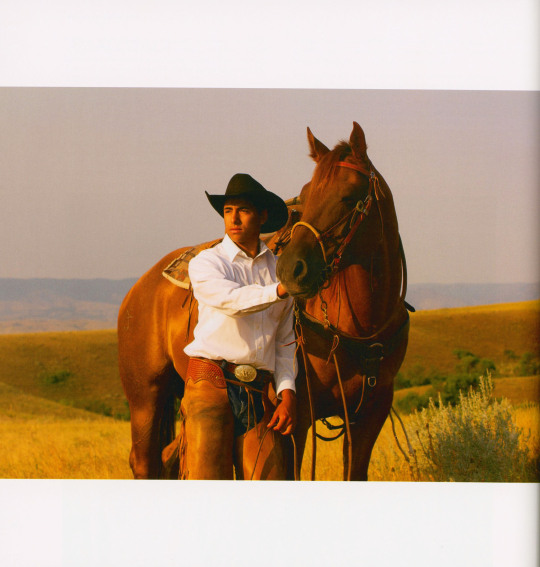
STEPHEN YELLOWTAIL
Apsáalooke (Crow Nation)

LEI'OHU and LA'AKEA CHUN
Kānaka Maoli

ORLANDO BEGAY
Diné
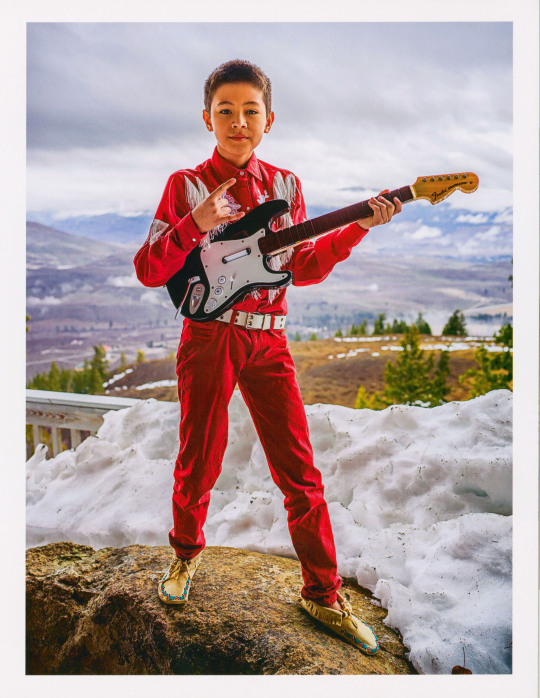
KALE NISSEN
Colville Tribes
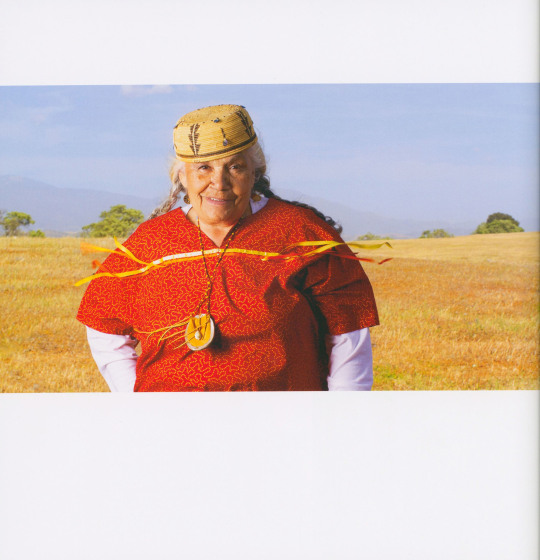
GRACE ROMERO PACHECO
Santa Ynez Band of Chumash Indians

ISABELLA and ALYSSA KLAIN
Diné

NANCY WILBUR
Swinomish
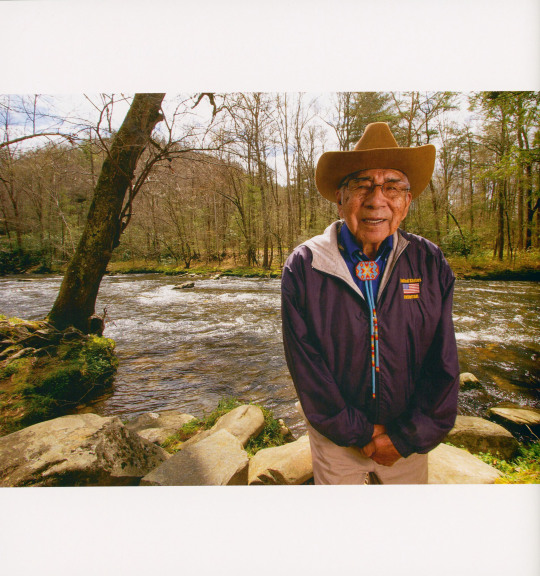
DR. JEREMIAH "JERRY" WOLFE
Eastern Band of Cherokee Indians

RUTH DEMMERT
Tlingit
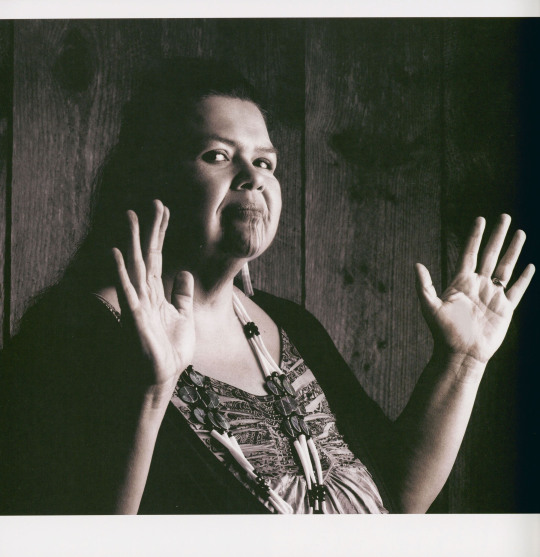
MARVA SII~XUUTESNA JONES
Tolowa Dee-Ni' Nation, Yurok, Karuk, Wintu
Matika Wilbur will be speaking on UW-Milwaukee's campus Thursday, November 16 from 6-7p.m. in conjunction with her exhibition Seeds of Culture: The Portraits and Voices of Native American Women on view at the Union Art Gallery November 16 through December 15, 2023.
-Jenna, Special Collections Graduate Intern
We acknowledge that in Milwaukee we live and work on traditional Potawatomi, Ho-Chunk, and Menominee homelands along the southwest shores of Michigami, part of North America’s largest system of freshwater lakes, where the Milwaukee, Menominee, and Kinnickinnic rivers meet and the people of Wisconsin’s sovereign Anishinaabe, Ho-Chunk, Menominee, Oneida, and Mohican nations remain present.
#indigenous people's day#matika wilbur#project 562#Ten Speed Press#Native Americans#holidays#UWM Native American Literature Collecton
810 notes
·
View notes
Text
★ NEVER SAY NEVER. [ 009 ] flowers on vines.

synopsis. something about the eight most well-known boys of your campus just didn't sit right with you, so you never gave any effort to interact with them. but after a series of… interesting incidents, they can't seem to leave you alone. pairing. college students! vampires! ot8! ateez x fem! reader. genre. fluff, angst, eventual smut, college au, vampire au.
chapter warnings. mildly suggestive content, implication of size kink. word count. 3k
chapter viii // chapter ix // chapter x

With a week left for the project, thirteen out of the fourteen had come and gone with the snap of a finger. You were aware time seemed to go so fast because of the person you were partnered with. Wooyoung had a way of getting the most stubborn of people to have the most fun. Meeting with him—and his friends, or, you supposed, your friends—nearly every day a week for months, it wasn’t a surprise that it went by so quickly.
You worked very well together, a shock to you initially but after getting so close to him it made sense. Not to mention how close you’ve gotten to his friends, who you now also considered some of your own best friends and loved. Not that you loved them, but you thought they were cool and fun and nice and unbelievably handsome and-
Your thoughts were quickly cut off by a knock on your studio door that cut through the music playing from your bluetooth speaker. Well, “studio” was a bit of an exaggeration.
When you and Sangmi first moved into this apartment, it became apparent to the two of you that there was an extra room. Of course, knowing that she was a dance student and probably practised for the majority of the day, you let her have the extra room but she quickly shot you down and told you to use it for your art instead. It wasn’t spacious enough to be a dance studio, anyway.
There was space for your assortment of shelves and easels, a long table stretched the length of the wall under the single window in the room, paint tubes, brushes and palette knives scattered all over the surface and various filled sketchbooks, new and scrapped canvases crammed just below the table on the equally long shelf.
You set a small couch next to the door, the wall behind it decorated with several of your paintings you favoured over the others. Sometimes, while you were working, you let Sangmi sit on the couch and relax, either watching you or doing something of her own as you enjoyed each other’s presence.
You set your paintbrush down next to your palette on the table and wiped your paint stained hands on a cloth before opening the door.
“Hey, I’m gonna go to the dance studio for a few hours.” Sangmi told you as you stepped aside to let her in. She looked at the painting of Wooyoung you were working on, the reference picture a screenshot of the dance video he filmed, taped to the top part of the easel. “Oh, it’s coming along so well!”
Over the past weeks she’s been checking on you and your progress, reminding you to eat whenever you get too carried away with painting. She’s seen all the stages and all the discarded versions of the painting, as well as all your frustration when you couldn’t get things to look quite right.
The canvas was fairly large, a magnificent oil painting of Wooyoung finally living up to your visions on the fabric—so you figured there wouldn’t be a need for smaller paintings as well. The dance was a contemporary one, choreographed to a song that made use of traditional instruments and performed on the stage of the university’s auditorium. The part you chose to paint was an almost breathtaking point of the choreography where he switched from sharp movements to an almost trance-like slowness, looking up with one hand elegantly reaching upwards. There was no denying his talent.
The lighting from the stage’s spotlight was already dramatic, but you tweaked it on your canvas, adding more contrast and a soft glow to his illuminated features to create a more jarring effect. He looked ethereal with the way you painted him.
A couple minutes later, Sangmi left and you could continue painting in peace. Well, until the doorbell rang, at least. With a groan, you set your paintbrush down and walked into the hall to see who you needed to buzz in. As soon as you saw who was waiting outside the building, your eyes lit up and you wasted no time in hitting the button to unlock the door.
You practically ran to the bathroom to wash the paint off your fingers. By the time he arrived at your door, you already cleaned yourself up a bit and made a bit of an effort to sort out your messy hair. With a deep breath, you opened the door and practically threw yourself on him.
“Gosh, I thought I’d never see you again!” You pretended to cry into his chest as your embraced him tightly.
But Yunho only chuckled, ruffling your hair. “Oh, don’t be dramatic.”
You were only half joking. With you focused on your painting and him having to attend shootings and rehearsals for the end of year movie of the acting students, you hadn’t seen each other in a while. Each of the artistic majors had some kind of collaborative showcase near the end of the year; this year art majors and dancers worked together, the film majors worked with the actors, and the music majors worked with the theatre students. For that reason, you couldn’t find a lot of time to see half of the boys in general.
“That’s an ironic thing to say for an actor.” You stepped away from him with a giddy laugh, noticing the bags in his hand and pointing at them. “What’s that?”
“I’m glad you asked,” Yunho smiled and walked past you to set the bags on the small breakfast table between the kitchen and living area. “I brought food. I didn’t know what you wanted,” he began taking different containers out of the bags, “so I got a variety—some soups, tteokbokki, fried chicken, japchae, gimbap and, of course, rice.”
“Thank you so much, but really didn’t have to get all this-“
He cut you off with a wave of his hand. “Don’t worry about it, I want to treat you to some delicious food.”
After a moment of you biting your lips with uncertainty, you nodded gratefully and moved to the kitchen to grab utensils and bowls.
The two of you conversed comfortably as you stuffed yourselves full with the food he brought. You asked about the movie but he’d only give you answers so vague he may not have said anything at all; “What is it about?” “Well, you know, characters and stuff.” “Yunho, please!” “Ok, ok, fine… it’s a romance and involves characters.”
Though you didn’t really notice it, he paid a lot of attention to you. Whether you were talking or just eating, he was constantly taking notes in his mind. When you briefly mentioned a movie you liked, he later reminded himself to watch it when he had the time. Or when your eyes gave a slightly different reaction to a particular dish that showed you enjoyed it, he later reminded himself to make sure to order that dish next time he brings you food. Even when he was the one talking, he was so focused on the warmth in your face as you listened to him that he nearly lost his train of thought several times.
You told him about the progress of your painting, but adamantly refused to show it to him even when he begged so prettily. However, he quickly quelled his curiosity as you said something about wanting to surprise him and the rest of the guys. Something unfamiliar in his chest clenched when you giggled at his pout, reaching your hand over to pat his forearm.
“But I want to see your paintings!” He huffed jokingly, making you laugh again.
“I can just paint something for you out here.”
He seemed to be considering the offer for a while and then his pout disappeared, his eyes lighting up even though there was a darker glint in his eyes you couldn’t quite decipher. A smirk spread across his face.
“What if… you paint me?”
“Yeah, sure, I’ve thought about using you as a reference so-”
“No, no, you misunderstood me,” he let out a mischievous little chuckle that twisted your stomach, “I mean, what if you paint on me?”
“O-oh…” Mildly surprised by the request, you blinked. “Are you, um… are you sure you’d want that?”
His eyes crinkled as he smiled at you. “Of course I do! But if you don’t feel comfortable doing it, you don’t have to.”
With a newfound determination to make him happy, you nodded and got up, telling him to stay where he was seated while you went to grab some paint. Deciding oil paints weren’t the best idea, you settled on gouache, something between watercolour and acrylic that would wash off easily. You grabbed a few clean brushes and walked out with everything in your hands.
The sight that waited for you in the living room had your breath caught in your throat. Yunho was still there, as you had asked, but he had gone to the bathroom and grabbed a towel to lay on the floor.
He was on top of the towel.
Laying face down.
Shirtless.
You were glad he wasn’t facing you, otherwise he would’ve seen the way you had to turn around to pull yourself together. There was no denying how well-built Yunho’s body was—or any of their bodies, in fact—but seeing it so bare, despite only seeing his back, did things to you. For the sake of the friendship, you swallowed down the nervousness bubbling inside you and turned back around, grabbing a cup of water and a small towel from the kitchen before walking to where he laid himself down and kneeling next to his body.
You set your supplies next to you and took a breath. He sensed you next to him and turned his head to look at you sideways.
“Something wrong, tiny?”
The nickname only added into that static feeling of nervousness but you still shook your head, beginning to dip one of the brushes in water. “Everything’s fine, just relax, please.”
Yunho nodded and sighed softly, turning his head to the other side and closing his eyes. As you inspected your colour palette, you took a moment to think of what to paint on him. What would he like?
Finally, you decided to just let your hands take over instead of thinking about it too carefully. Knowing him, he’d be happy no matter what you decided to draw. Holding your breath, you let the brush lathered with paint touch his skin. There was no mistaking the way the hair at the nape of his neck stood up with goosebumps as he shivered ever so slightly. You briefly apologised about the paint being cold, but he didn’t mind at all.
You drew a wavy, thin, sage green line from his left shoulder diagonally down to the left side of his waist, watching as the damp bristles glided over his muscles. They weren’t as defined as an athlete’s, but they were there, soft indications of his fitness.
As you let your mind and paintbrush wander, you found yourself turning that line into a vine of flowers and leaves. The style was almost impressionistic, barely abstract and precise smudges of colours that resembled plants you didn’t know the names of. With each stroke of the brush and twitch of his muscles, your shoulder relaxed and you let yourself bask in the moment just as he was.
Soon enough, you were happy with your creation and sat back to inspect it. Feeling the absence of your brushstrokes, Yunho turned his head to look at you again.
“Done?”
You tilted your head one way and then the other, looking at it from different angles before nodding with satisfaction. He gave you a toothy smile.
“Do you wanna do the front too, tiny?”
“Sure- wait, what?” Your eyes snapped to his, his question making your face feel warm. Painting on his naked front torso seemed considerably more… intimate than painting on the plane of his back.
“Yeah, like, paint on the front? Maybe you can connect the designs.”
And so you found yourself painting a similar vine on his chest after he laid himself on his back—of course, he had waited until you told him the paint was dry in fear of ruining your hard work. This vine started from his waist where the vine on his back ended and creeped up to his neck, disappearing behind his ear.
Throughout the process, you had to keep reminding yourself not to let your hands indulge in a few caresses of his porcelain skin, gaslighting yourself into believing he was just a canvas. But the way he was looking at you didn’t help much.
His eyes almost looked glossy as the reflection of the ceiling lamp’s light danced in them, looking at you with something you could only compare to adoration. You didn’t hate it at all, but you weren’t sure how to feel about it.
You also weren’t sure how you ended up in this position. At some point you must’ve been so focused, you didn’t notice him move you to sit on his upper thighs. Straddling him. But you didn’t want to make things awkward and move off him (not to mention that you greatly liked this position), so you stayed and continued your work from on top of him. You desperately tried to ignore the size difference that seemed so much more obvious when you were on him like this while he, on the contrary, revelled in it.
And at first you could feel your heart pounding in your chest, threatening to break through your rib cage. But the erratic beating soothed itself; it calmed down quickly when it came to terms with the fact that you were safe in his vicinity. He was safe.
Painting his front was similar to his back, his muscles twitching every time you brushed over them with paint. Now that you were seeing him like this, you nearly asked him never to put on a shirt again.
You found yourself adding details that were ultimately meaningless and would most definitely go unnoticed, but you weren’t quite ready to move away from him. Not when he was looking at you with such round, tender eyes.
“Can I take a picture of this?”
His voice seemed slightly deeper than usual, perhaps because he hadn’t used it in a while. His question briefly caught you off guard, but you realised that it was kind of cute, really. So you nodded without lifting your eyes from the area you were painting just next to his abs.
Yunho’s hand reached over to the coffee table and he slid his phone off the surface. First he took a picture from his own point of view, looking down his chest to see one of your hands painting gorgeous flowers while your other one rested on his free hand’s forearm, the way you straddled him so perfectly just further down the shot.
The next picture he took was a landscape oriented photo, his hand outstretched to the side. This shot depicted the scene from the side, both of your smiling faces in the picture, as well as the bend of your arm as you painted near his neck and the soft arch of your back as you leaned over him ever so slightly. The way his free hand’s fingers rubbed and tapped their way up your thighs until they reached your waist went unnoticed by the camera.
While you were very focused on painting, you did eventually relax enough to let your own free hand explore his torso. With one hand focused on refining the flowers, the other glided over wherever the paint wasn’t touching, following the dips and rises of his body. It wasn’t until you accidentally passed your thumb over one of his nipples that he made an effort to stop you.
When it happened, he let out a shaky breath that seemed somewhat like a silent whimper, he raised a hand to close around your wrist and lifted it away from his chest. After he muttered a “tiny, please” you nodded and relaxed your hand in his grip, face flushing out of embarrassment.
Instead of dropping your hand, he repositioned his hold on it to cradle it gently, pulling it to his face and consequently pulling you further up his lap. You gaped at him as he pressed an electric kiss to your knuckles. But he didn’t stop there; he flexed your wrist to present your palm to him, his eyes never breaking contact with yours until his kisses trailed to your wrist. His lips lingered over your pulse point and you watched as his eyes fluttered shut.
It was impossible to deny the dark tint appearing on your cheeks, but you were glad to see he looked just as affected. Pink blush adorned his soft cheeks, his eyes seeming slightly dazed when he finally dropped your hand and looked up to you.
It wasn’t long after that that the paint fully dried and he had to leave, voice hoarse as he explained that he had an early shooting the next day and should probably go rest. After helping you clean up, Yunho pressed a quick kiss to your cheek, barely missing the corner of your lips, and took off into the night.
If you collapsed onto the couch and squealed into a pillow as soon as he was gone, that was nobody’s business but yours.
And if as soon as he got home, he practically ripped off his shirt and gushed to his brothers about how small and pretty you looked when you were on top of him—foregoing showing the pictures because those were for him and only him—that was also nobody's business but his either.

[ lilo's notes ... ] thank you all for waiting so patiently for this chapter <33. as you can see, you and yunho are quite… close 🤭 i honestly had so much fun writing this, possibly too much- but anyways, i hope you enjoyed it!! also, don’t worry, i did not forget about that little yeosang moment from the previous chapter, it will most definitely be brought up~~
ଘ(੭˃ᴗ˂)੭ network ... @cromernet @blankjournal
ଘ(੭˃ᴗ˂)੭ taglist ... @atinytinaa @marievllr-abg @pocketjoong @moonsangie @sarahleighflora @kiss-hwa @kyukyustar @cqndiedcherries @ateezourstars @kitty4hwa @hyukssunflower @aestheticsluut @neohyxn @mrowwww @darkdayelixer @itsokaytobedumb00 @hwa-sans @purplelady85 @seongfury @meginthebuilding27 @stopeatread @mothworked @foliea @euphoric-emily16 @teezers99 @mulletjoonsupremacy @imalildelulu @sunukissed @blehhhidk @ad0rechuu @brxken0rex @strawberry-moonpies @bluehwale-main @lightinythedark @stupefystudies @yandere-stories @skz-enthusiasttt @seongwin @huachengsbestie01 @galaxypox @moonminji @lilactangerine @lelaleleb @asjkdk @honey-lemon-goose @stayteezdreams @diorwoo @yunho0o0o0o @majestickitty @shookykookie30 @0325tiny
#★ — › NEVER SAY NEVER !#cromernet#ateez#ateez x reader#seonghwa x reader#hongjoong x reader#yunho x reader#yeosang x reader#san x reader#mingi x reader#wooyoung x reader#jongho x reader#vampire au#college au#fluff#eventual smut
510 notes
·
View notes
Note
abby looks so comfy i jus want to fall asleep on her shoulder or smth during a meeting n then wake up, tucked in bed and snuggling with her, taking a mid-afternoon snooze ☹️ is that too much to ask
she is so cozy!! I feel like abby, specifically college basketball abby, isn't much of a nap girlie on her own, because she always feels like she's wasting daylight? but then she meets you and you're dragging her into naps at like noon on a Sunday and genuinely, it's like heaven. she loves waking up with her girl in the hazy afternoon light, warm and fuzzy and still a little sleepy, you curled up at her side. there's nothing better!!
her favorite is when you fall asleep on her lap while she's reading on her armchair, the baby blue vintage armchair you two thrifted. she'll be sitting there, reading my brilliant friend or jane eyre or just kids or severance, with the coffee you made her on the table. you're sleepy from all the tasks you got done that morning, so abby let you crawl into her lap and you almost immediately passed out on her shoulder. it's so sweet and domestic and it's her favorite Sunday tradition <3
also what do we think abby would read? because im feeling a mix of classics, contemporary, lots of like ,,, Patti smith and Joan Didion? if you get my vibe? and fantasy, of course <3
#anon#abby anderson#abby anderson x reader#abby anderson fluff#abby anderson x reader fluff#college basketball abby x chubby reader
228 notes
·
View notes
Text
Alabama could soon begin using its newly constructed gas chamber to carry out what would be the first-ever execution using nitrogen hypoxia. Alabama's new gas chamber has never been tested and a new protocol for carrying out an execution using nitrogen hypoxia was released with extensive redactions.
...
Members of the Jewish community who indicate so when they sign on to this petition are also adding their name to the following stand-alone statement:
JEWISH COMMUNITY STATEMENT OPPOSING THE GAS CHAMBER
Jewish tradition presents somewhat contradictory statements regarding the death penalty. While the Torah permits the death penalty, the Talmud, in Tractate Sanhedrin, imposes severe limits on capital punishment even where the crime is murder. Contemporary US laws do not meet the standards for fairness and accuracy as articulated in Jewish law. Today we are writing not about the death penalty as a whole, but about proposed forms of execution.
Certainly there are members of Jewish communities in states using the gas chamber who support the death penalty in concept or in practice. However, we stand united in opposition to the introduction of the gas chamber as a form of execution. We do not suggest comparisons to the atrocities of Nazi Germany under which millions of our relatives were murdered, many by suffocation in sealed chambers. Still, we cannot imagine it possible that Jewish communities anywhere could stand by while prisoners are executed by the state in our names, using any variation of that mechanism.
Therefore, the undersigned Rabbis, Cantors and other leaders the Jewish community call on you to reject the conduct of executions by suffocation in any sort of gas chamber anywhere in the United States.
#death penalty#anti death penalty#gas chamber#jewish community#judaism#petition#action network#death penalty action#alabama
109 notes
·
View notes
Text
Shadowhunter Headcanon/Promptlet: Traditional Dress
Shadowhunters began separating themselves from the mundane world in the first or second century AD, and many of the ways they live in Alicante haven’t progressed much since that time, especially their manner of dress.
While those nephilim stationed at Institutes have transitioned into wearing more contemporary mundane-style clothing so they don’t have to be glamoured every time they leave their own enclaves, most nephilim still wear the knee length (or floor length) belted Roman tunics when at home.
In the six months or so they've been dating, Magnus has only ever seen Alec in mundane, era-appropriate clothing. Alec has been the Commander of New York for so long that he rarely has the opportunity to relax - even in his own rooms at the Institute Alec is typically in clothing suitable for quickly throwing patrol leathers over in emergencies.
However, when Alec moves in with Magnus, he realizes how much it means to him that Magnus doesn’t treat Alec as a guest or as company- but treats him as if he belongs there, as if his home is Alec’s home too.
Alec loves seeing Magnus in his elaborate Consular High Warlock wardrobe, but he adores seeing him in a pair of soft leggings and a loose, comfortable T-shirt, something reserved solely for intimate nights spent relaxing together in the loft.
Realizing how much it means to him that Magnus is so overtly comfortable around him, Alec hopes the reverse might be true as well and impulsively decides to make an impromptu trip to Lightwood manor after a Clave meeting. The backpack with a few of his favorite tunics is unpacked at the loft later that day in just a few minutes.
The next night, Magnus emerges from the bath in buttery-soft, neon pink leggings and one of Alec’s old shirts. Alec swallows dryly even as Magnus’ eyes gleam in simple pleasure at Alec’s reaction while he demands Alec switch out his patrol leathers for something more comfortable before joining him on the couch.
Alec happily agrees and heads into the bedroom to change. Tentatively, however, he reaches for one of the comfortably worn tunics he grew up associating with true relaxation instead of the sweats he learned to make do with in New York.
#shadowhunters#malec#lawsofchaos rambles#alec lightwood deserves nice things#promptlet#shadowhunter culture#probably not at all historically accurate
81 notes
·
View notes
Text
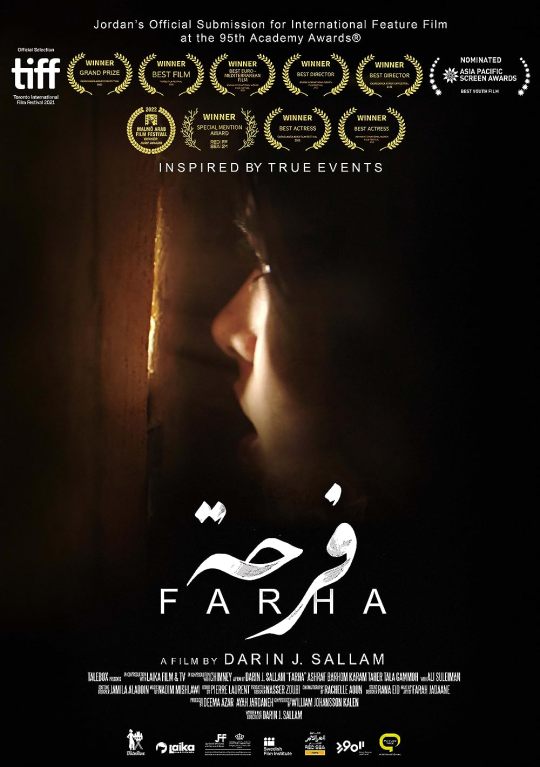









10 films on Palestine that everyone should watch
Explore the tales of Palestinians who have suffered atrocities at the hands of Israeli occupation forces for 75 long years.
ith the Gaza invasion dominating headlines around the world and Israel carpet bombing the Gaza strip, killing scores of civilians, we have complied a list of films that highlight the plight of Palestinians so that people remember the human stories behind the statistics.
United Nations Secretary-General Antonio Guterres, in a Security Council meeting held on October 24 to discuss the Middle East situation, asserted, “It is important to also recognise the attacks by Hamas did not happen in a vacuum. The Palestinian people have been subjected to 56 years of suffocating occupation. They have seen their land steadily devoured by settlements and plagued by violence; their economy stifled; their people displaced and their homes demolished.”
His powerful statement rings true as Palestinians have been suffering under the apartheid rule of Israel for far too long. Palestinian people have tried various ways to raise their voices and tell the world about Israel’s atrocities, which have been ongoing since the Nakba in 1948. One of the most successful methods has been telling real stories through films, dramas, and documentaries.
Here are 10 films that depict how the people of Palestine have suffered for the past 75 years.
Farha (2021)
The film depicts the true story of a Palestinian girl who survived the Nakba of 1948, when thousands of Palestinians were expelled from their homeland. The hopeful young girl who wanted to study in the city watched silently from the pantry of her house while Israeli forces ethnically cleansed her neighbours and other fellow countrymen slaughtered by them.
The movie, directed by Hassiba Freiha and Kenton Oxley, is available on Netflix.
Tale of the Three Jewels (1995)
Set in contemporary Gaza, the movie is the story of a Palestinian boy, Yusef, who becomes entranced with a beautiful Gypsy girl. The children explore nature, mysticism, and their future while learning to live amid the surrounding brutality. To escape, Yusef sets off on a journey to the North American dreamworld with his blind neighbour.
Directed by Michel Khleifi, the movie is available to watch online on various sites.
Children of Shatalia (1998)
Farah, age 11, and Issa, age 12, are two streetwise children living in Beirut’s Palestinian Shatila refugee camp, located in the city’s “belt of misery.” The centre is home to 15,000 Palestinians and Lebanese who share a common experience of displacement, unemployment, and poverty. The two children are given video cameras; they use their imaginations and creativity to come to terms with the realities of growing up in a refugee camp that has survived massacre, siege, and starvation.
Directed by Mai Masri, the movie is available on Netflix.
Omar (2013)
Omar is a young Palestinian man living in Israeli-occupied West Bank where he must navigate a steep separation wall and checkpoints to visit his friends. Omar sees his horizons diminish after he carries out a sniper attack with his two childhood buddies. He’s captured, imprisoned, tortured, and coerced into becoming an informer for the Israelis but finds he’s not the only traitor.
Directed by Hany Abu-Assad, the second film from the Palestinian territories to be nominated for an Academy Award is available on Netflix.
Pomegranates and Myrrh (2009)
The film tells the story of a Palestinian woman who uses Dabke (a traditional folk dance) to cope with the loss of her husband, who is taken away by Israeli authorities. The story talks about the political climate of Palestine and the internal and external sufferings of Palestinians.
Directed by Najwa Najjar, the movie is available on Netflix.
Eyes of a Thief (2014)
The film’s central plot-line is a father’s search for his daughter. As he searches, he not only has to fight against the lack of freedom under occupation but also against social boundaries. Having served a 10-year prison sentence for an attack on Israeli border soldiers, Tarek sets out to find his daughter Malak. When he eventually finds her in Nablus, however, he discovers that she has been adopted. He can’t reveal himself publicly as her father, so he takes a job nearby working as an engineer for the official in charge of water at the Palestinian National Authority to be able to approach her in secret.
Directed by Najwa Najjar, the film is available on Netflix.
The Time That Remains (2009)
This semi-autobiographical film tells the story of a father who fought in the 1948 war and chose to stay back when Israelis took over. It depicts the life of Palestinians living as a minority on their own land. The film is divided into four parts.
Directed by Elia Suleiman, The Time That Remains is available for streaming on Apple TV.
3000 Nights (2015)
The film illustrates the plight of political prisoners in Israel. Set in 1980, Nablus, 3000 Nights follows a newly-married school teacher, Layal, whose crime is giving a ride to a teenage boy who is accused of executing a lethal attack on a military checkpoint. Layal is sentenced to eight years in prison, where she spends her pregnancy and gives birth to a boy.
Directed by Mai Masri, the film is available on Netflix.
The Present (2020)
A father-daughter duo living along the Palestine border sets out to buy a fridge. The pair has to cross the checkpoint, segregated road, and armed soldiers, which involves a stringent checking process to cross the border. The movie depicts the life of Palestinians who can’t do basic daily routine things without facing harassment by IDF soldiers.
Co-written and directed by Farah Nabulsi, the BAFTA Award-winning film is available on Netflix.
When I Saw You (2012)
This story focuses on the heartache of a young boy, Tarek, who wants his father and his state back. He is displaced in a grim camp, with no one to turn to, and proceeds on a journey to turn his life around.
Directed by Annemarie Jacir, the movie is available on Netflix.
If you are interested in the historical context of the Israel-Palestine conflict, take a look at this list compiled by Al-Jazeera.
As Israeli forces bomb Gaza relentlessly to ‘punish’ Hamas, killing thousands of innocent Palestinians, it is important to remember their stories.
Words courtesy of images.dawn.com
#human rights#art#humanity#equal rights#freedom#women's rights#freedom for palestine#freegaza#freepalestine#movies#when i saw you#netflix#farah nabulsi#bafta#hamas attack#the present#gaza strip#free gaza#3000 nights#the time that remains#myrrh#pomegranate#omer#omar#childrens of shatila#farha#united nations#peace#al-jazeera#image.dawn.com
99 notes
·
View notes
Text
The Third Blade: Hinalung - Handheld Speartip
Five days left to go before the launch of the Gubat Banwa Kickstarter campaign!
Gubat Banwa is a TTRPG that allows you to play as warrior Kadungganan in the Sword Isles, a fantasy setting as colorful and intricate as the Southeast Asian cultures from which it draws inspiration.
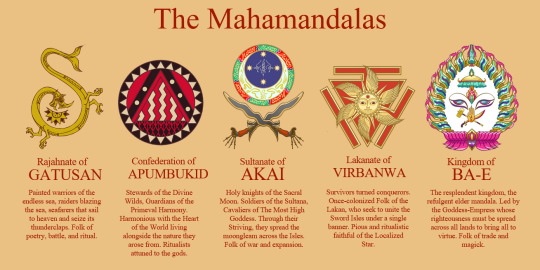
I've been posting the weapons I've been drawing for the game as kind of a countdown, leading up to the launch on October 10. I was planning to do this for Swordtember, but sometimes you gotta shift the goalpost a little bit.
3/7 blades down, behold the HINALUNG
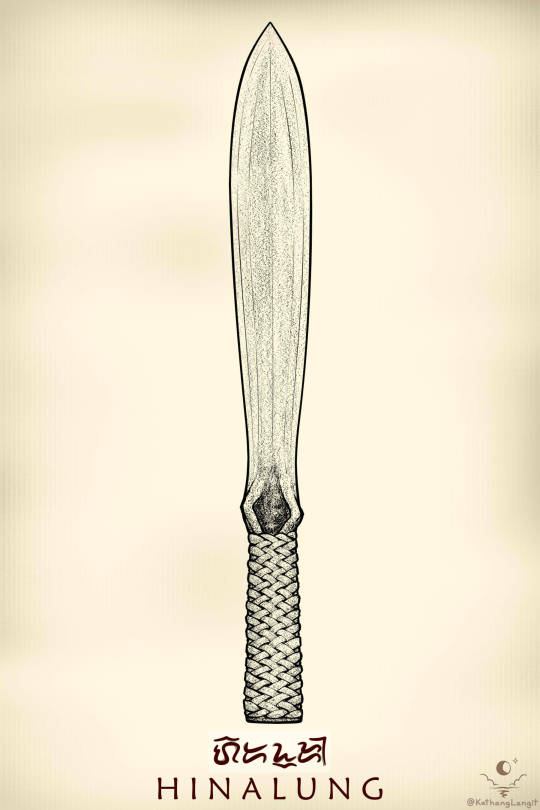
This multi-purpose blade comes in a few different shapes and sizes, but in general they are symmetrical and double-edged. They don't get much longer than one's forearm, and more often than not have handles wrapped in rattan lashings.
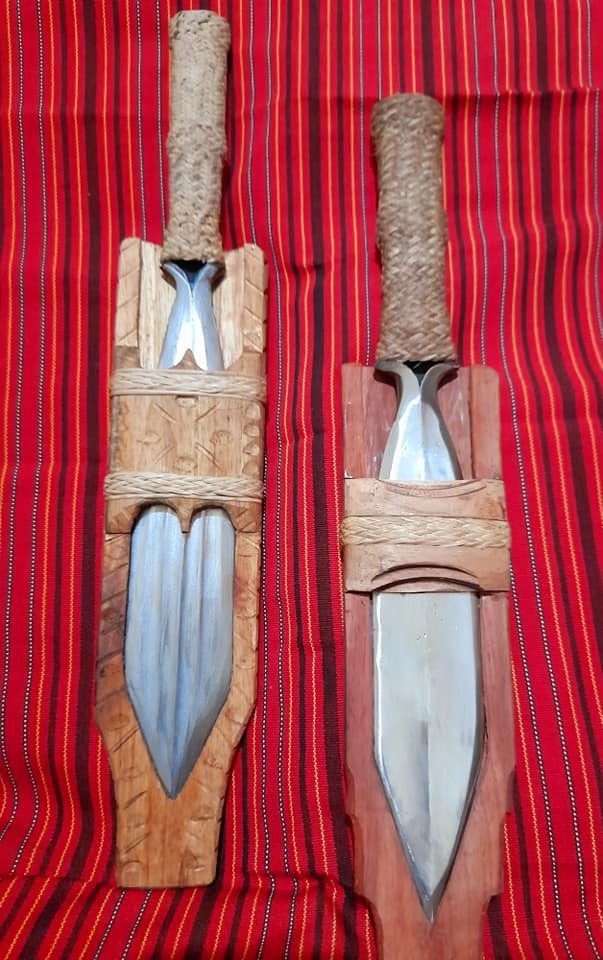
(Blades by Tatang HImanggo and one of his students- a certain Arnold; As shared by Biboy's Sharp Edges)
If I'm not mistaken, the term "hinalung" is Ifugao- referring to a certain group of indigenous peoples in the Philippine Cordilleras- though the usage of the blade itself was widespread across the mountains of north Luzon. Nowadays, it isn't just Ifugao smiths making them, and a number of contemporary smiths from across the region seem to lay claim to the blade.
In any case, the blade is of the Cordilleras, unconquered by Spain.
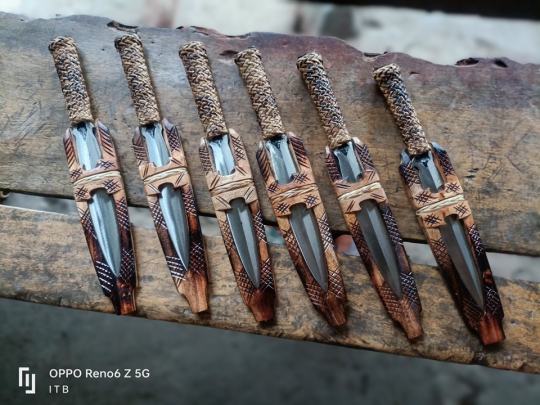
(Blades by Ifugao Traditional Blades)
One more thing of note is the open scabbard, which seems to be common among blades in that region- not just the hinalung.
Some of them boast enough space for more than one blade to be sheathed, and are often sold as novelties. The first example below has a large hinalung in the middle, joined by a pair of pinahig.
It can very quickly get out of hand. These X-in-1 sets are usually sold as novelties.
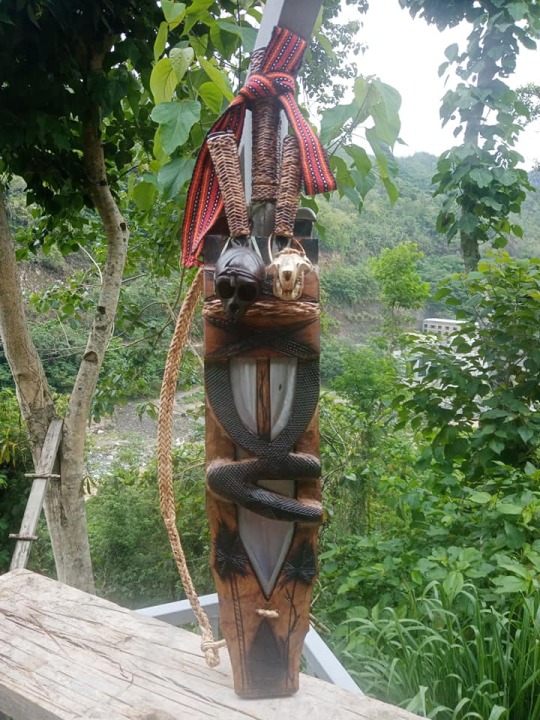

(Blades by Orinn Mongalini/Panday Anitu Mumbaki)

(Photo from Orinn Mongalini)

(Photo from Ifugao Artistic Blade)
Now for the fun part!
You may be wondering why the handle is shaped the way it is, with that triangular opening near the base of the blade?
Or perhaps you read the title of this post and you already know where this is going?

They double as spearheads!
The handle itself is steel folded in to create a hollow socket, allowing the hinalung to be mounted on a wooden shaft, turning it into a spear. Supposedly, this spear-form was used for hunting.
You can see the hollow socket more clearly here:
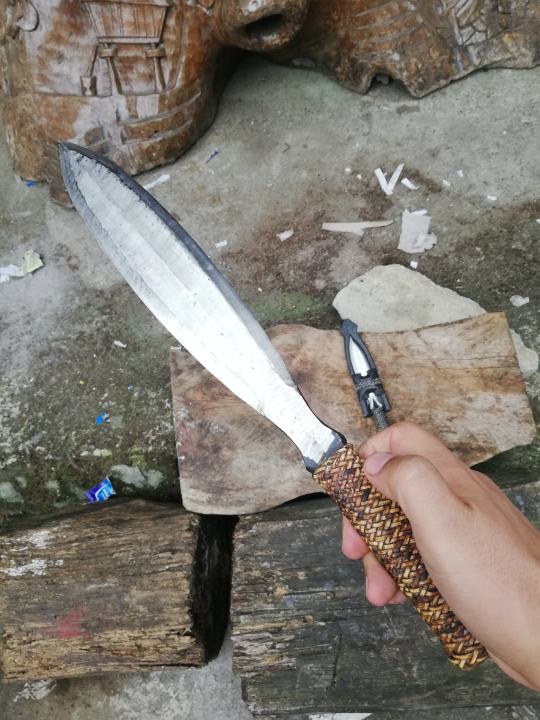

(Blade by HanYan Blades)
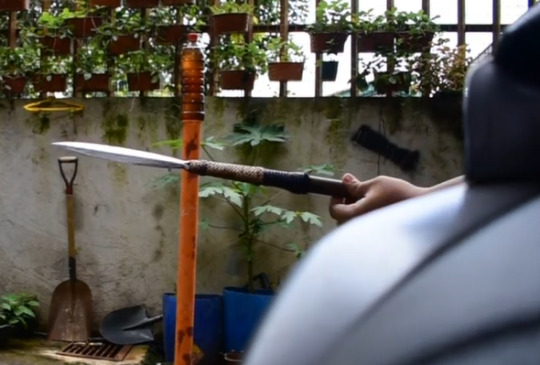
(Screencap from a video by AJ Blade Reviews testing the blade as a spear; Blade by Lakay Paul Dulnuan Sr.)
As mentioned previously, the Philippine Cordilleras were never conquered by Spain, and as such were able to carry their traditions with a little more ease into the present day.
It is very much apparent in the blade culture.
Present-day smiths in the Cordilleras still forge hinalung, some of them stating they do it in the traditional way, others admitting to hewing to more modern methods.
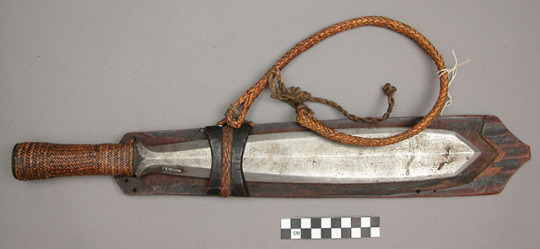
(Antique from the Peabody Museum of Archaeology and Ethnology)
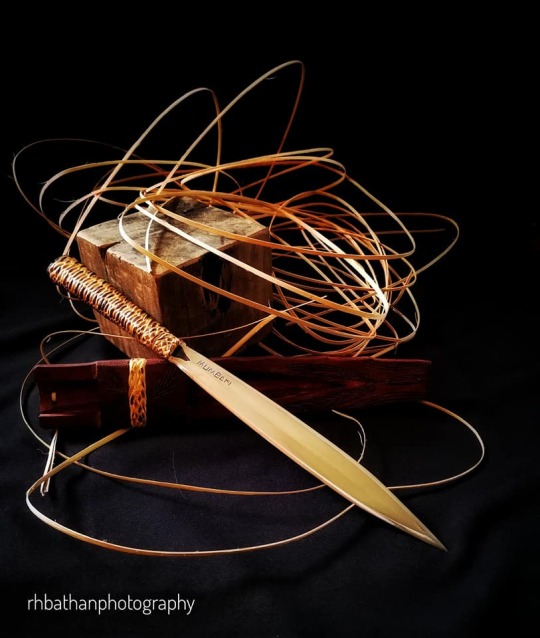
(Modern build by Lakay Pabian, photo by Ramon Bathan)
Like I said before: Blade culture is alive and still developing.
One of the Five Major Mahamandalas of Gubat Banwa pays homage to and gleans inspiration from living cultures like those I mentioned here. If you want to know what the first half of that sentence means, check out the game and its Kickstarter!
The Gubat Banwa Kickstarter launches in 5 days! Check it out here:
I've watched this game be started, written, and developed by like- one guy, who just managed to drum up enough interest and meet enough people willing to help shape the dream, and make it what it is today. It could not have gotten this far without all of them.
Still, it remains a very small team of creators from the global south, with very limited resources. We would dearly appreciate any and all help in getting the word out about the game!
#gubat banwa#gamedev#ttrpg#ttrpgs#indie ttrpg#indie ttrpgs#tabletop rpgs#rpgs#rpg#southeast asia#southeastasia#dnd#kickstarter#swords#philippine blade#weapon design#dagger#philippine history#philippine culture#filipino artists#artists on tumblr#kathang langit#help us get the word out!#fantasy#fantasy worldbuilding#swordtember#bolo#itak#hinalung#igorot
95 notes
·
View notes
Text
cheatsheet to your slav folkloric downfall
Since several people had questions about the lore that inspired this poll, I'll jot some notes down about what I was thinking. All of these have long and complex tradition that can't possibly fit in a tumblr post, but there's tons of great content on tumblr alone, so pls feel free to scroll through my tags for more info (you may like "demons", "witches", or "original art" for contemporary interpretations of the lore...) or use this post as a springboard for more research.
Because much of Slavic folklore was passed down orally and not written down, and because it covers a wide geographical range and is told in different languages, there are many versions of common stories, tropes, characters, etc.
***
Baba Yaga is a witch, super popular, tons of great lore about her, historical and contemporary. She was never just one single entity, but rather a version of herself in many different stories (more like fanfiction than like canon). Her character is inherently unpredictable, existing outside our societal rules and moral compass, and the variability in lore makes her even more impossible to predict. A young woman named Vasilisa did manage to perform all of Baba Yaga's tasks to her instruction, but not without her own magical help. Sometimes Baba Yaga is helpful and reasonable, and sometimes she will just casually eat you like a handful of berries. You never know what you're going to get.
The fern flower is a beautiful mythical flower that offers its holder immense knowledge and magic. It blooms very briefly only once a year during Noc Kupały (in Polish, the EN is Kupala Night). If you want to find it, you'll probably grab your boyfriend (gender neutral) around dusk and poke around your local woods for a while before giving up and just making out and then meeting up with your friends afterwards like "did you find it?" "no we didn't find it :( did you find it?" "nooo :(". Really, this is about seducing the boy you like, since you probably need magic just to see the flower anyway. If you do manage to find it and pick it, tons of greedy demons will appear and chase you to attempt to take it from you (and your life). You have to outrun or outsmart the demons. The demons may be metaphors for the corrupting forces of great power.
There are tons of ways to get lost in the woods. Some people help themselves by tying ribbons to trees as they go, but anything can spook you -- you can run into a demon, a werewolf, a ghost, a witch, a cat, anything -- and if you have to run away, you will most likely lose your way in the process. More specifically, if you have annoyed a leshy (a forest spirit/god-type thing who protects nature), he will use magic to confuse you, and even if you're very good at Not Getting Lost In The Woods, you're kind of screwed. You think YOU won't piss off the Leshy? Oops you just stepped on his favorite beetle -- screwed. Leshy can be placated with offerings of food and drink, but sometimes he needs something bigger...
There are actually lots of hot girls who live in lakes, much to the delight of about 20% of you, but probably the most common are the rusalki -- dead girls who experienced some tragedy in life, probably ending in drowning, and are now exacting revenge on the living, especially men. They will seduce you, take you into the water, and drown you with their hair, or possibly tickle you to death. Baby marry me, amirite? The original rusalka lore was probably nicer to them, treating them more like water spirits than vengeful ghosts. Rusalki are not mermaids and appear as women with legs. We do have mermaids, but usually these are river or sea beings -- the most famous is probably Syrenka Warszawska (the Warsaw Mermaid) who lives in the river Wisła and will not attempt to kill you unless you're trying to invade Warsaw, but also she's a warrior queen and you have no shot.
Slavic mythological entities love riddles, and if you're good at riddles you are really going to help yourself, but you don't want to get into that situation unless you have no other choice. A common demon you meet on the side of the road will probably not give you a hard one, but Poludnica (the Slovak name) will find you at high noon while you're working hard in the fields and the sun's been beating down on your head since dawn and you're feeling woozy and dehydrated, and she'll give you the hardest riddle you've ever heard, and you're going to blow it, and she's going to cut off your head with her scythe or give you heat stroke. If it's any consolation, she may be hot (pun intended). Pro tip: you may also wield riddles to your advantage. Demons are as egoistic as you are and can be enticed into solving your riddle. If you stump them, you may assure your safe getaway.
Human characters in Slavic lore tend to be young and naive, representing the listener of the tale, since they can't use magic or navigate the world they are entering. Knowledge and magic are two sides of the same coin, so if you want to survive, you will need to gain some wisdom (learning some riddles will help). Being nice is not good enough, but! If by being nice you manage to seduce someone who has access to knowledge and magic, or get adopted by a bored witch with an axe to grind, you'll really help yourself out.
The path to the endless dead wood is guarded by a giant magical cat, whose name I never knew but have recently learned that the Russians call him Baiyun (latinized name, obvi). If you ask Vasilisa, she'll tell you that sometimes he lives with Baba Yaga, but generally he hangs out on the boundary to some other dimension. Probably, if you go to meet the cat, it's because somebody sent you there to get rid of you, so if you survive the cat, whoever is trying to kill you will probably keep trying so fyi. Baiyun will purr or tell a tale in such a soothing way that you fall asleep, and then he'll eat you. If you manage not to fall asleep, you may attempt to catch him and earn magic. But probably you're cat food.
***
There you have it. If you learned your story differently, let me know! And if you're ever lost in a Slavic forest, you can put your clothes on inside out and maybe that'll break the magic. Good luck.
#slavic folklore#your slav folkloric downfall#demons#witches#deities#baba yaga#leshy#original art#original writing#rusalka#poludnica#poludnitsa#cat baiyun
193 notes
·
View notes
Text
Preserving Leaf Paintings in an Anglo-Indian Commonplace Book, 1822-1825
Hello, I’m Alexa Machnik, a third-year graduate student at the Conservation Center, Institute of Fine Arts, NYU. I first came to the Barbara Goldsmith Preservation & Conservation Department in Fall 2022 as a student in the graduate course, Conservation in Context, taught by Laura McCann, Director of Preservation. During this course, we delved into the world of library conservation, exploring the value systems that guide preservation decision-making and treatment action in academic research libraries. One of my class projects involved rehousing delicate leaf paintings from an early 19th-century commonplace book, or friendship album, part of the Fales Library holdings in the Special Collections at NYU Libraries (figs. 1-2) [1]. In honor of Preservation Week, I will share the intriguing history of the book and discuss the decisions that were made to preserve the leaves.

Figure 1 [left]: Front cover of the commonplace book, bound in gold-tooled red morocco leather.
Figure 2 [right]: Ownership label of “Jane Harriet [Blechynden]” on front marbled pastedown.
The book in question was compiled by Jane Harriet Blechynden (1806-1827) in England between 1822 and 1825. It holds her personal collection of handwritten and acquired materials, with contributions from her sisters, Emma and Sarah, who wrote original poems about sisterhood, separation, and their Anglo-Indian ancestry. The three women were the daughters of a British merchant residing in Calcutta, and while born in India, they were educated in England [2]. There is not a great deal known about Jane Harriet’s life in England, but her impending return to India in 1825 is documented in an emotional verse by Emma (fig. 3):
“Thus in parting my sister we’re breaking a link / Which may ne’er be united again / And firm as that chain was ‘tis painful to think / That absence may send it twain.”

Figure 3: Excerpt from the original poem, “Parting and a Meeting,” signed by Emma.
Jane Harriet’s book offers insights into her personhood, social connections, and sensibilities as an artist and collector. In addition to written entries, she inserted a compendium of acquired materials–pressed flowers, her own original drawings, and numerous paintings–between pages of the book (figs. 4-6).

Figures 4-6 [left to right]: A small sampling of the ephemeral treasures found in the book, including a dried pressed flower, a drawing on pith possibly by Jane Harriet, and a cut-paper silhouette.
Notably, six of these paintings are executed on the dried leaves of the Bodhi tree, a sacred plant indigenous to Asia with distinct spade-shaped, long-tipped leaves (fig. 7) [3]. Although leaf painting has origins in Buddhist traditions, by the time Jane Harriet collected her leaf paintings, it had already evolved into a form of Chinese export art in Europe. Her leaves depict secular scenes of contemporary life in China and botanical subjects, which are typical of the export genre (fig. 8). Their inclusion in the book implies that Jane was among the many people who partook in the avid collecting of China trade goods during the first few decades of the 19th century, a time when European fascination for Chinese culture and art was at its peak.

Figure 7: A leaf painting, as found loose in the book and partially lifted to show the thin, translucent nature of the leaf support.

Figure 8: Another leaf painting from the book, oriented with the leaf tip at the bottom of the image, depicting flowers and a butterfly.
The initial rush of excitement that I felt at finding the leaf paintings soon turned to concern as I gave thought to their long-term preservation at NYU Libraries, where researchers are expected to handle the book. The leaf paintings were loose in between the pages, which raised a series of “what ifs” about the potential dangers they could encounter. What if the leaves slip from the book? What if they bend or break as the pages are turned? What if the painted surfaces become abraded? The paintings were made with opaque pigment-based watercolors on exceptionally delicate, skeletonized leaves that have been primed with a thin organic coating. Despite being intact, their inherent fragility means that they are vulnerable to even the slightest touch. After considerable discussion, the Conservation Unit decided that in order for the leaf paintings to be preserved and safely accessed by researchers, they should be housed separately from the book.
I thoroughly examined the condition of the leaves and the painted surfaces in order to make a housing recommendation. Despite some minor damage, all were in stable condition. Thus, the ideal housing would provide support to prevent any further damage, such as paint loss and leaf breakage, and at the same time allow the leaves to maintain their translucency. To achieve this, I opted to mount them in double-sided window mats with a support made from clear polyester film, or Mylar® [4]. The addition of the Mylar® would not only create a stable surface for the leaf paintings but also enable the viewing of both sides (fig. 9).
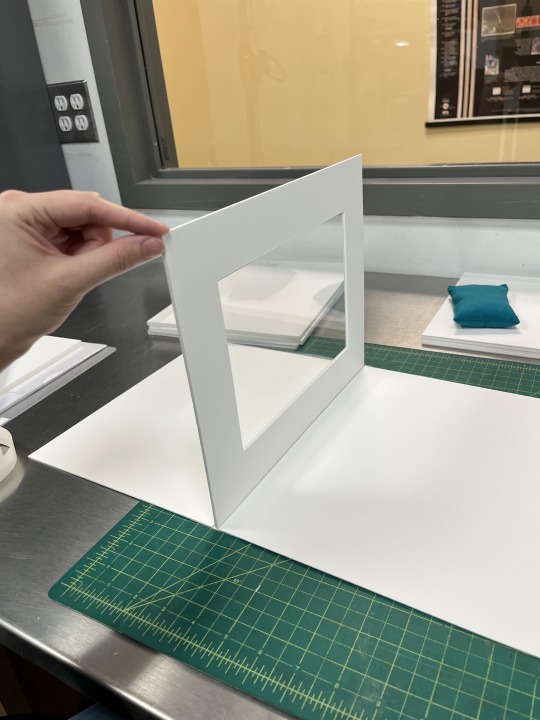
Figure 9: View of the double-sided window mat with a Mylar® support.
My next challenge was to figure out how to mount the leaves onto the Mylar® support without the use of adhesive [5]. After consulting with conservation staff and creating mock-ups, short, discreet Mylar® tabs were selected as the best option to secure them into place (figs. 10-11). For this process, I positioned a single leaf painting onto the support and selectively placed the tabs around its perimeter, making sure the tabs did not overlap any areas of paint. I then used a handheld spot-welding pen to fuse the tabs to the support. Since this process was done in-situ, near the leaf, it required lots of precision practice and encouragement from colleagues before I felt confident enough for the task.

Figure 10: Detail of a mounted leaf painting. Notice that the Mylar® tabs are welded just outside the leaf and extend minimally over the edges, holding it in place with gentle pressure.

Figure 11: The backside of a mounted leaf painting viewed through the Mylar® support. This gives researchers access to the painting’s verso, where an underdrawing and other signs of artistic process can be discerned.
At the time of writing this post, I successfully housed the six leaf paintings in their double-sided window mats (figs. 12-13). This housing project, while complete, is just one part of the ongoing effort to preserve the commonplace book, and the Conservation Unit is continuing work on other elements of the book to ensure its safe return to Special Collections.
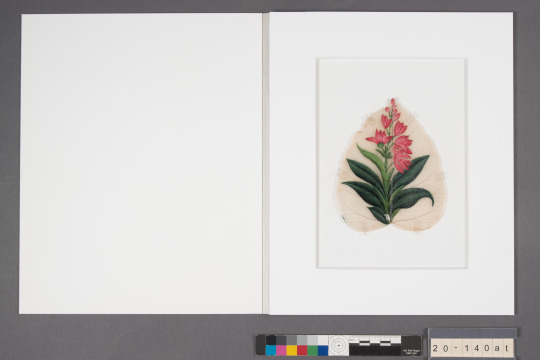
Figure 12: Example of the completed housing, showing the front of a leaf painting.

Figure 13: Back of a leaf painting.
Though my involvement in the project has come to an end, I have gained a very special appreciation for the commonplace book and the preservation challenges it presents. The experience of learning directly from NYU Libraries Special Collections was especially invaluable, providing me with opportunities to participate in complex decision-making processes unique to large research libraries driven by user needs. Before signing off, I’d like to extend my gratitude to my supervisors, Laura McCann, Director, and Lindsey Tyne, Conservation Librarian, and the entire team at the Barbara Goldsmith Conservation Lab for their unwavering support and enthusiasm throughout this project. Thank you all very much!
Notes:
[1] A commonplace book is a centralized place for an individual to record information, whether it be their personal thoughts or quotes from outside literary sources. Friendship albums, by contrast, contain handwritten entries from the family, friends, or acquaintances of the owner (often female). Both forms of commonplacing sustained popularity in Europe and America throughout the 19th century. To learn more about this fascinating literary genre, see Jenifer Blouin, “Eternal Perspectives in Nineteenth-Century Friendship Albums,” The Hilltop Review, Vol. 9, Issue 1 (2016) and Victoria E. Burke, “Recent Studies in Commonplace Books,” English Literary Renaissance, Vol. 43, No. 1 (2013), 153-177.
[2] Much of what is known about Jane Harriet (also known in her family as Harriet) comes from the Blechynden papers in the British Library (Add. Mss. 45578-663). This large holding contains the diaries of her father, Richard (Add. Mss. 45581-653), and older brother, Arthur (Add. Mss. 45654-61). For a secondary account of the Blechynden household, see Peter Robb, Sentiment and Self: Richard Blechynden’s Calcutta Diaries, 1791-1822 (New Delhi: Oxford University Press, 2011).
[3] Michele Matteini, “Written on a Bodhi tree leaf,” Anthropology and Aesthetics, Vol. 75-76 (2021), 45-58.
[4] The design of the double-sided mats is based on an instructional guide made available by the Library of Congress. “Double-Sided Mat,” Library of Congress, accessed 1 February 2023.
[5] We chose not to use adhesives or traditional paper-hinging techniques to mount the leaf paintings for several reasons. As noted, the paintings are on fragile, non-paper-based supports that have an organic coating, which may be derived from plant gum. The leaf supports are thin, translucent, and highly vulnerable to breakage, so applying hinges directly with adhesive might permanently alter their appearance or risk further damage to the leaves over time, especially if they need to be removed from the housing in the future.
Photographs: Alexa Machnik
#NYULibraries#NYUSpecialCollections#FalesLibrary#nyuifa#nyuart#librarypreservation#libraryconservation#collectionscare#artconservation#paperconservation#bookconservation#artpreservation#preservingthepast#PreservationWeek#preservationweek2023
208 notes
·
View notes
Text
The Tenant of Wildfell Hall - Chapter 38, “The Injured Man”
This chapter - the one where Lord Lowborough learns about Annabella and Huntingdon’s affair - is extremely interesting to me in relation to some of the things I learned in an undergrad history on Britain. (CW: Discussion of sucide.)
Starting in the 1700s, and continuing into the period when The Tenant of Wildfell Hall was written, there was a strong push among the growing middle classes for moral reform, and one of the things it targeted were vices that were specifically seen as common ones of the upper class: gambling, drunkenness, duelling, and suicide. The last one seems strange to the modern eye, but one element of its context was the image of the aristocrat who got badly into debt through the first three vices and killed themselves to escape disgrace (‘disgrace’ meaning ‘behaviour considered unfitting to the upper class’, like having to do work to earn money), to which the middle class were in effect responding “what, so you think an honest day’s work is literally a fate worth than death?”) The rest of the objection to it was the same as the objection to duelling: that both treated the balue of human life lightly. This was a sharp turn away from the older upper-class culture: the idea of suicide in dire straits as a virtue went back to Ancient Rome (and earlier, but I think Ancient Rome was the big reference point), and duelling had long been considered a necessary hallmark of the honourable man.
Lord Lowborough’s part in The Tenant of Wildfell Hall (which is deeply within the 1800s-British tradition of moral-didactic literature) is that of a man who has been tempted by all of these vices (as well as by drug abuse), succumbed to some, but ultimately refused all of them, and this chapter is the culmination of that. Earlier in the book Huntington laughingly tells of his friend’s earlier struggles and temptations, and how Huntington and the rest of their club urged him on in them and tempted him back whenever he attempted to quit: how Lowborough was first financially ruined by his gambling addiction, and then (in a striking example of addiction displacement) turned first to alcohol and then, as a displacement of alcohol, to laudanum to numb his unhappiness. He had ultimately managed to quit both, and married Annabella in hopes that marriage and domestic happiness could keep him on the straight and narrow. And he does actually stick with quitting them.
This chapter is the conclusion of that, and stands out for how different it is from the treatment of duelling in other (relatively) contemporary novels. In Sense and Sensibility, there’s a mention of Colonel Brandon fighting a duel with Willoughby over Willoughby’s seduction and abandoment of his ward; Elinor Dashwood does not exactly approve, but neither does she strongly object, and it narratively adds a certain romantic and dramatic gloss to Colonel Brandon. It is not treated as a vice, but as a difference between female/male and civilian/soldier values (and moderated by the fact that it waa apparently a matter of form, and Brandon was not trying to kill him, as indicated by the lack of injury):
“we met by appointment, he to defend, I to punish his conduct. We returned unwounded, and the meeting, therefore, never got abroad.”
Elinor sighed over the fancied necessity of this; but to a man and a soldier, she presumed not to censure it.
In Jane Eyre, Rochester also mentions, in the past, having a duel with the man who had been sleeping with his mistress Céline Varens. As with Colonel Brandon, this isn’t regarded as praiseworthy, but it does give him a more dramatic figure.
“Next morning I had the pleasure of encountering him; left a bullet in one of his poor etiolated arms, feeble as the wing of a chicken in the pip, and thought I had done with the whole crew.”
In contrast, The Tenant of Wildfell Hall has Helen effusively praise Lowborough for refusing to fight a duel, in the teeth of his friends’ condemnation of that decision as weak and cowardly. It’s not mildly tut-tutting at duelling: it’s flipping the aristocratic script by presenting refusal to duel under circumstances that would normally prompt one as actively morally courageous.
[The first speaker is Hattersley, one of Lowborough and Huntingdon’s friends.]
“If you’ve the heart of a man, it would be the very ticket for you. It’s just this, my lad,” he continued, rather lowering his voice, but not enough to prevent me from hearing every word he said, though the half-closed door stood between us: “I think you’re an ill-used man—nay, now, don’t flare up—I don’t want to offend you: it’s only my rough way of talking. I must speak right out, you know, or else not at all; and I’m come—stop now! let me explain—I’m come to offer you my services, for though Huntingdon is my friend, he’s a devilish scamp, as we all know, and I’ll be your friend for the nonce. [This is Hattersley offering to be his second in a duel.] I know what it is you want, to make matters straight: it’s just to exchange a shot with him, and then you’ll feel yourself all right again; and if an accident happens—why, that’ll be all right too, I daresay, to a desperate fellow like you. Come now, give me your hand, and don’t look so black upon it. Name time and place, and I’ll manage the rest.”
“That,” answered the more low, deliberate voice of Lord Lowborough, “is just the remedy my own heart—or the devil within it, suggested—to meet him, and not to sever without blood. Whether I or he should fall, or both, it would be an inexpressible relief to me, if—”
“Just so! Well then—”
“No!” exclaimed his lordship, with deep, determined emphasis. “Though I hate him from my heart, and should rejoice at any calamity that could befall him—I’ll leave him to God; and though I abhor my own life, I’ll leave that, too, to Him that gave it.”
“But you see, in this case,” pleaded Hattersley—
“I’ll not hear you!” exclaimed his companion, hastily turning away. “Not another word! I’ve enough to do against the fiend within me.”
“Then you’re a white-livered fool, and I wash my hands of you,” grumbled the tempter, as he swung himself round and departed.
“Right, right, Lord Lowborough,” cried I, darting out and clasping his burning hand, as he was moving away to the stairs. “I begin to think the world is not worthy of you!”
Lowborough’s rejection of duelling is also a rejection of suicide (“and though I abhor my own life, I’ll leave that to Him that gave it”), and this rejection in spite of strong temptation is further emphasized:
I lay awake the greater part of [the night] listening to his heavy step pacing monotonously up and down his dressing-room, which was nearest my chamber. Once I heard him pause and throw something out of the window with a passionate ejaculation; and in the morning, after they were gone, a keen-bladed clasp-knife was found on the grass-plot below; a razor, likewise, was snapped in two and thrust deep into the cinders of the grate, but partially corroded by the decaying embers. So strong had been the temptation to end his miserable life, so determined his resolution to resist it.
Helen’s internal thoughts give further praise of Lowborough, and condemn the social values that make being cheated on a greater source of shame and condemnation for a man than cheating is:
"That man," I thought, "is an object of scorn to his friends and the nice-judging world. The false wife and the treacherous friend who have wronged him are not so despised and degraded as he; and his refusal to avenge his wrongs has removed him yet farther beyond the range of sympathy, and blackened his name with a deeper disgrace. He knows this; and it doubles his burden of woe. He sees the injustice of it, but he cannot bear up against it; he lacks that sustaining power of self-esteem which leads a man, exulting in his own integrity, to defy the malice of traducing foes and give them scorn for scorn—or, better still, which raises him above earth's foul and turbulent vapours, to repose in Heaven's eternal sunshine. He knows that God is just, but cannot see His justice now: he knows this life is short, and yet death seems insufferably far away; he believes there is a future state, but so absorbing is the agony of this that he cannot realize its rapturous repose. He can but bow his head to the storm, and cling, blindly, despairingly, to what he knows to be right. Like the shipwrecked mariner cleaving to a raft, blinded, deafened, bewildered, he feels the waves sweep over him, and sees no prospect of escape; and yet he knows he has no hope but this, and still, while life and sense remain, concentrates all his energies to keep it. Oh, that I had a friend's right to comfort him, and tell him that I never esteemed him so highly as I do this night!"
I feel that Anne Brontë was trying to make women’s rights - specifically, the right to 1) be treated as morally and intellectually equal to men, and not as either angels to inspire or delicate flowersto be preserved; 2) be taught the dangers of a bad marriage fully and frankly in order to avoid them; 3) leave an abusive marriage, and to have forms of abuse other than physical abuse recognized as abuse, and to keep custody of their children on leaving such a marriage; and 4) have some way of earning a respectable independent living upon leaving such a marriage - an integrated part of the wider moral reform movement, and both those threads are strongly present throughout her book. (In some respects this succeeded, at least insofar as the suffrage movement and the temperance movement were very closely tied together. It’s not always remembered enough that a huge element of the temperance movement was the right to not have your husband be drunk all the time (often leading to violence) and waste all your money.)
#the tenant of wildfell hall#wildfell weekly#anne bronte#helen graham#lord lowborough#cw suicide#tw suicide
25 notes
·
View notes